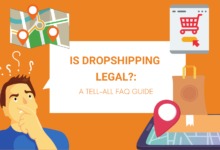
Meet Sophia Amoruso, the founder of Nasty Gal. She began by selling clothes on eBay. This small start grew into a big online retail company. Sophia’s journey shows how online thrift stores create chances for both entrepreneurs and fashion fans.
The pre-owned market will hit about $77 billion by 2025. This is double the amount in 2021. Online thrift stores are growing 11 times faster than normal clothing stores. Young people, especially Generation Z, are leading this movement. They are starting online thrift stores and sharing their used and vintage items on social media.
More people are choosing second-hand items over new, fast fashion because of sustainability. This choice is a big reason for the demand in pre-owned goods. Platforms like Depop and Poshmark have helped a lot. They let young people sell items and earn money from their styles.
Creating an online thrift store is easy and affordable. Unlike physical stores, you don’t need big money upfront. This makes it a great opportunity for new business owners. Whether you want to tidy up your closet, make extra money, or start a retail business, an online thrift store is a good way to go.
Also read: Ecommerce Automation: Streamline Your Online Business (moumentec.com)
Key Takeaways
- The pre-owned market is expected to reach $77 billion by 2025, growing 11 times faster than the general retail apparel sector.
- Generation Z consumers are driving the online thrift store trend, selling used and vintage products on social media platforms.
- The movement towards sustainability has led to increased demand for second-hand items over fast fashion.
- Online thrift stores have low upfront costs, making them accessible to first-time business owners.
- Starting an online thrift store can help declutter your closet, earn passive income, or build a successful retail business.
Finding Your Niche for an Online Thrift Store
Starting an online thrift store, picking your niche is key. The market for used clothes is growing fast. It’s expected to reach $351 billion by 2027, says Statista research. To pull ahead, decide what you’ll sell. Make sure it’s what your customers want.
Pick a niche for your thrift shop to beat the competition. Clothes, shoes, books, electronics, and home goods are good choices. Think about what you love, what people are buying, and what’s hard to find.
Defining Your Product Category
Choose a special kind of thing to sell in your store. If you focus on clothes, you could sell only vintage dresses or rare sneakers. This makes your shop the go-to for that stuff.
Curating Your Selection
After picking your stuff, now pick your items. Choose things that fit your niche and that people will like. Here are some pointers:
- Go for items in great shape.
- Find unique pieces to shine.
- Keep up with what’s popular in your niche.
- Offer variety in sizes, colors, and styles.
By offering a mix of cool and different items, you’ll make shopping great. This will make customers come back to buy more.
| Niche | Examples | Target Audience |
|---|---|---|
| Vintage Clothing | 1950s dresses, 1970s bell-bottoms, 1980s leather jackets | Fashion lovers, collectors, and eco-friendly shoppers |
| Retro Sneakers | Air Jordans, Adidas Superstars, Puma Clydes | Shoe fans, athletes, and stylish people |
| Antique Jewelry | Art Deco brooches, Victorian necklaces, 1920s earrings | Jewelry lovers, history fans, and fashion fans |
Focusing on a niche and carefully choosing what to sell can make your thrift store shine. With work and passion, it’s possible to make a great income. And you’ll be helping the planet by offering affordable and green choices.
Creating Your Brand Identity
When starting your online thrift store, think about what you want to offer. It’s more than just picking a name or logo. Consider your vibe and appeal to customers. Ask yourself important questions to build your brand identity:

Defining Your Target Audience
Imagine your perfect customer. Picture their age, gender, hobbies, and lifestyle. It helps to know who will love what you sell. This shapes what you offer, how you talk, and where you advertise.
For instance, appealing to younger customers might call for trendy items. Platforms like TikTok and Instagram could be key for reaching them.
Establishing Your Unique Selling Proposition
What makes your thrift shop unique? In a crowded market, standing out is important. Key points could include:
- Being the go-to for vintage clothes or handmade goods
- Offering top brands at great prices
- Having a unique selection of items
- Focusing on eco-friendliness and sustainability
Once you’ve figured out your audience and what’s special about your shop, it’s time for a name. Your brand name should be catchy and reflect what you stand for. Make sure it’s not already taken.
From your logo to how you talk about your products, keep things consistent. Telling a clear, appealing brand story will help you connect with customers. This is key to making your thrift store a hit.
Setting Up Your Online Store
The U.S. online retail industry topped $1 trillion in revenue last year. This makes starting an online thrift store a smart choice for those in the ecommerce business. To begin, you have three main paths: use an ecommerce platform, create your own website, or sell through online markets such as eBay or Facebook Marketplace.
Choosing an Ecommerce Platform
If you’re starting out, go for user-friendly ecommerce platforms like Shopify or Wix. They come with easy-to-use templates, perfect for beginners without technical skills. These platforms, even if a bit pricier, are popular due to their convenience. Shopify, for instance, costs $29 a month and covers all your online store needs.
Building a Self-Hosted Website
If you’re tech-savvy and have time, consider a self-hosted website using WordPress. This method gives you full site control and can be more cost-effective over time. Customizing your website fully, however, does require some coding. It’s a good option for those with technical know-how, such as owners of craft or antique stores.
Deciding between a platform and a self-hosted site depends on various aspects like ease of use, customization, and cost.
| Factor | Ecommerce Platform | Self-Hosted Website |
|---|---|---|
| Ease of Use | Very user-friendly, ideal for beginners | Requires technical knowledge and coding skills |
| Customization | Limited to available templates and features | Highly customizable with coding knowledge |
| Cost | Monthly subscription fees, but all-inclusive | Potentially cheaper, but requires separate hosting and plugins |
| Scalability | Easy to scale as your business grows | Highly scalable, but may require technical adjustments |
The best platform for your thrift store depends on your tech skills, budget, and goals. Think carefully, whether setting up a boscov’s online store or a my vet store online, to ensure you pick the right platform for your specific needs.
Sourcing Inventory for Your online thrift store
Finding good inventory is key for your online thrift store’s success. With more people buying online and enjoying secondhand items, the timing is perfect. You can find great goods to sell by using different sources. This way, your store’s collection will be varied and attractive to buyers.

Visiting local thrift stores like the Salvation Army online or others is a great start. They offer a big range of things, from clothes and accessories to home décor and collectibles. Keep going back to find special items, which will make your inventory strong.
Don’t forget about yard and estate sales. They often have many items for sale at lower prices. Talking to those who organize these sales and to fellow thrifters can give you good info on where to find great deals.
Online sites such as eBay are also useful. They let you find and buy what you need from home. Watch out for business sales or storage auctions; you might get a lot of items for less.
It’s important to pick items that match what your store is about. Choosing well-made, timeless things helps draw in and keep customers. Always adding new items is also vital to keep your store interesting and have people coming back.
| Inventory Source | Advantages | Considerations |
|---|---|---|
| Local Thrift Stores | Wide variety of items, regularly updated inventory | Time-consuming, competitive environment |
| Yard Sales & Estate Sales | Discounted prices, unique finds | Seasonal availability, inconsistent quality |
| Online Platforms & Auction Sites | Convenience, targeted searches | Shipping costs, potential bidding wars |
| Business Liquidations & Storage Unit Auctions | Large quantities of inventory, discounted prices | Unpredictable contents, storage and transportation logistics |
As you look for items for your online thrift store, remember to be enthusiastic and not give up. Running a good business needs hard work and patience. With your effort and the ability to find great treasures, you can build a store that people love and choose over others online.
Managing and Storing Your Products
Starting a resale business means having a good system for your inventory. The second-hand market is growing fast and is expected to be worth $82 billion by 2026. So, it’s key to keep your products in order for a smooth operation.
Inventory Management Systems
Using inventory software can make your job easier. It tracks your items, shows what’s selling well, and helps you know when to restock. If you have a store and sell online, a POS system can link your inventory both places.
When you pick software for your business, think about these:
- How well it works with your online shop and POS
- Having live updates on stock
- Using barcodes for easy tracking
- Getting reports and insights
- Can it grow with your business?
Storage Solutions for Your Products
Over time, you’ll need more space for your products. Starting at home is okay, but you’ll want a bigger, long-term plan. Many sellers rent storage units for their goods.
When choosing a place to store your items, think about these:
| Factor | Description |
|---|---|
| Size | Make sure the space fits what you have now and what you’ll add later. |
| Location | Being nearby is helpful so you can easily check on your stock. |
| Security | Look for secure places with cameras, locked gates, and alarms to keep your items safe. |
| Climate Control | If your items can be damaged by heat or cold, a climate-controlled space is crucial. |
| Cost | Compare prices to find a good deal that won’t blow your budget. |
How you manage your stockroom is as important as storing your stuff. Keep your items organized the same way you do online. Use labels and have different spots for new items, orders going out, and any returns. This keeps everything running smoothly.
Creating Compelling Product Listings
To make your online thrift store successful, create captivating product listings. Spend time on engaging descriptions and photos. These can show off your unique items and draw in customers. Doing market research helps you know what your audience likes. This info can make your listings more appealing to them.

Writing Engaging Product Descriptions
Product descriptions should focus on what makes items special. Use words that help customers imagine using them. A story can make the item feel more personal to your audience.
To make your items easier to find online, use important keywords in your descriptions. This also helps your store show up in search results. Choose these words by looking at what people search for. By adding them carefully, more people might see your items.
| Element | Description |
|---|---|
| Unique Features | Highlight the distinctive characteristics that set your products apart from competitors |
| Benefits | Emphasize how the product can improve the customer’s life or solve a specific problem |
| Storytelling | Incorporate personal anecdotes or historical context to create an emotional connection |
| Keywords | Integrate relevant search terms naturally throughout the description to improve SEO |
Taking High-Quality Product Photos
Good visuals are key in online shopping. Use high-quality images to show your items well. A clear, well-lit picture can help shoppers see the details.
Show products from different angles to give a full view. For clothes, show them on models to see how they fit. For home items, set up the scene to make it look appealing.
- Use a high-quality camera or smartphone with a good lens for sharp, clear images
- Ensure proper lighting to avoid shadows and highlight product details
- Choose a clean, uncluttered background to keep the focus on the product
- Provide multiple angles and close-up shots to give customers a comprehensive view
- Use lifestyle shots or styled vignettes to help customers envision the product in use
Combine great descriptions with top-notch photos. This will make your thrift store stand out. As you learn more about your market, you can improve your store’s image. This can help you grow a loyal customer base over time.
Pricing Your Products for Profit
Choosing the right prices for your online thrift store is key. It helps make your store profitable and draws in customers. Think about the market value, condition, unique aspects, and demand of your items. Looking at prices for similar new items can give you a good starting point.
There are several pricing strategies for thrift stores. You can use percentage markdowns, fixed prices, or adjust prices based on demand. Percentage markdowns are good for varying the price by an item’s age or condition. Fixed pricing offers consistency for your buyers. Lastly, demand-based pricing lets you change prices depending on how popular an item is.
Determining Your Markup Strategy
Aim for a markup that keeps both your customers and your wallet happy. Most resale retailers stick to a 300% markup. Yet, this can differ among online thrift stores. Reflect on whether to mark prices above or below this percentage. If you buy a vintage dress for $30, try to sell it for $90.
When deciding on markup, think about these factors:
- How much your products cost initially
- Packaging, shipping, and selling costs
- Fixed costs for running your business
- The item’s condition, brand, how rare it is, and if it’s in season
Analyzing Competitor Pricing
Keeping an eye on what your competitors are doing is crucial. Use platforms like eBay to track their prices. This info is key for staying competitive and making smart pricing choices. It helps you know when to adjust your own prices.
| Pricing Strategy | Description | Benefits |
|---|---|---|
| Percentage Markdowns | Pricing items based on age and condition | Encourages sales of older or less desirable items |
| Fixed Pricing | Maintaining consistent prices across similar items | Simplifies shopping experience for customers |
| Demand-Based Pricing | Adjusting prices according to item popularity and market trends | Maximizes profitability for high-demand items |
Good pricing and watching market trends can boost your thrift store’s profits. It will also help you build a strong group of regular customers. Use thrift store software to help you price right. It uses past sales and current trends to guide your pricing.
Shipping and Fulfillment Strategies
When your online thrift store picks up, you need smart shipping and fulfillment plans. A reliable logistics partner makes your work smoother and keeps your customers happy. Descartes Systems Group offers a top-notch warehouse management system for e-commerce. This system runs on the cloud and helps automate and grow your order fulfillment.
With Descartes’ system, make your brand known for great, scalable service. You’ll send items on time with no errors. You’ll also know exactly what’s in your warehouse. Plus, you’ll start seeing benefits quickly. It’s great for small and medium online thrift stores that want great shipping but also care about the environment.
Goodfair, from Houston, is a great example. They’re using Descartes’ system to keep up with more shoppers interested in secondhand items. By automating, they’ve cut out errors and made the warehouse more visible. This change has made their customers happier and let them grow without hurting the planet.
| Shipping and Fulfillment Best Practices | Benefits |
|---|---|
| Automate order processing and tracking | Reduces manual errors and improves efficiency |
| Implement a warehouse management system | Enhances inventory visibility and control |
| Partner with reliable shipping carriers | Ensures timely and cost-effective delivery |
| Offer multiple shipping options | Provides flexibility and convenience for customers |
| Communicate shipping updates to customers | Builds trust and improves customer satisfaction |
Follow these practices to boost your thrift store. Make sure your orders stand out in the online market. With the right moves and tools, you will thrill your shoppers. At the same time, you’ll build your business in a way that’s kind to the earth.
Marketing Your online thrift store
Marketing and promotion are key once your online thrift store is running. You want to attract customers and increase sales. With the right methods, you can show off your items and gain loyal customers.
Building an Online Presence
Having a strong online presence is vital for success in e-commerce. Use a website that’s easy to navigate and shows your brand well. Make sure to use keywords and to post content that your audience finds helpful.
Add other online platforms to reach more people. Make profiles on Facebook, Instagram, and Twitter. Share attractive product photos, useful descriptions, and special deals. Answer your followers’ comments and messages quickly. This will help build a strong online reputation.
Leveraging Social Media Platforms
Use social media advertising to promote your thrift store, even on a tight budget. With platforms like Facebook and Instagram, you can target ads to your ideal customers. Develop ad campaigns that highlight your items and draw customers to your site.
Working with influencers in your niche can also increase your thrift store’s visibility. Find influencers who match with your brand and ask them to collaborate. Influencer marketing can introduce your products to more people and establish your brand’s trustworthiness.
| Marketing Strategy | Benefits |
|---|---|
| Social media advertising | Cost-effective, targeted reach, increased brand awareness |
| Influencer collaborations | Expanded audience, increased credibility, potential for user-generated content |
| Email marketing | Direct communication with customers, personalized offers, increased customer loyalty |
| Local marketing efforts | Increased foot traffic, community engagement, potential for partnerships with local businesses |
Use a mix of these strategies and give great customer service. This will help your thrift store grow and make people loyal to it. Always check how your marketing is doing and change as needed to get the best results.
Conclusion
Nowadays, starting an online thrift store has become a great idea. More than 75% of people like buying used clothes online. Also, the market for secondhand items is growing. It’s expected to be worth $64 billion in the next five years. By following the steps in this guide, you can make a successful online store.
Remember, it takes effort to run a thrift store online. Keep improving how you find items. Stay up to date with what’s popular and make sure customers are happy. The market for online secondhand items is increasing fast. By 2022, it’s set to be $41 billion. This means there’s a lot of room for your business to do well.
If you’re looking to make extra money or start a new career, an online thrift store is a good choice. You’ll offer cool and planet-friendly clothes. This will attract more and more people. Take the first step today and start your online store. With the right approach, your store will be a hit.
FAQ
How profitable are online thrift stores?
Online thrift stores can make good money. By 2025, the used goods market could hit billion. Some sellers boost their monthly earnings by a few hundred dollars. Others make up to ,000 a month selling online.
What are some tips for finding a niche for an online thrift store?
For your store’s niche, pick a special type of item. Focus on a certain era or style. For instance, you might choose to sell only vintage dresses from the 50s or 60s.
How important is branding for an online thrift store?
Brand building is key for your store. Make sure your brand fits what your customers like and what makes you different. Pick a short, catchy name. And match your logo and design with your brand message.
What are the best options for setting up an online thrift store?
You can start your store in three main ways. Use an ecommerce platform, build your site with WordPress, or sell on big sites like Amazon. Ecommerce platforms are the best choice for most new sellers.
Where can I source inventory for my online thrift store?
There are many places to find things to sell, like thrift stores and estate sales. Start small to avoid spending too much. Choose items that fit your store’s style and are likely to sell quickly.
How should I manage and store my products for an online thrift store?
It’s important to keep track of your inventory and where it sells. Use software to help. At first, you can store things at home. But as you grow, you might need a storage unit. Always keep your items organized.
What makes a compelling product listing for an online thrift store?
Good product listings have clear descriptions and great photos. Use plenty of light and show items in a nice way. Use models or pretty settings to help buyers see how they could use the item.
How should I price my products for profit in an online thrift store?
When setting your prices, look at your costs and what others are charging. Consider all costs, including shipping and fees. A 300% price increase is often a wise goal, but it may vary for different stores.
What are some effective marketing strategies for an online thrift store?
To spread the word about your store, focus on social media. Use platforms like Instagram and Facebook. Connect with customers and other sellers. Create a buzz before you open to build excitement.
Source Links
- How to start an online thrift store
- How to Start an Online Thrift Store in 10 Easy Steps
- How to Start an Online Thrift Store in 2022- The Ultimate Guide
- How To Start An Online Thrift Store
- How to Start a Thrift Store: Idea to Online Success
- How to Start an Online Thrift Store
- Starting an Online Thrift Store: Top 10 Tips
- How To Start an Online Thrift Store: A Step-By-Step Guide
- The Ultimate Marketing Strategy for Online Thrift Store | Markooo
- How to Create a Successful Thrift Online Store
- How to Start an Online Thrift Store in 7 Simple Steps
- How to start an online thrift store: The complete guide – Blog Instamojo
- Embarking on the thrifting adventure: A guide to launching your online thrift store business
- 3 Ways to Source Products for Your Online Store [and Save Big] | BigCommerce
- Retail Management 101: How to Get Inventory for an Online Boutique
- How To Start a Thrift Store in 2024 – Shopify
- How To Start An Online Thrift Store: A Step-by-step Guide
- How to Start an Online Thrift Store [5 Easy Steps]
- How to Start an Online Thrift Store?
- How to Start an Online Thrift Store – Hostziza
- Effective Thrift Store Online Marketing Tactics – Osum
- How to price thrift store items for maximum profit
- Thrift Store Pricing Strategy: Balancing Affordability and Profitability for Success
- Pricing Strategies for SVdP Thrift Stores, Part 2 – St. Vincent de Paul USA Member Site
- Online Thrift Store Goodfair Streamlines and Scales Fulfillment with Descartes Ecommerce Warehouse Management Solution | Supply Chain Dive
- Top Tips for Starting an Online Secondhand and Vintage Marketplace
- Online Reselling: Turn Thrift Store Finds into Profits
- How to Make Your Thrift Store Stand Out
- How to Successfully Tackle Marketing for Thrift Stores
- How to Start an Online Thrift Store in 10 Easy Steps
- The Rise of Online Thrifting
- A Guide on Starting an Online Thrift Store: Market Overview and Trends
- Thrift to Thrive: 7 Tips to Launch A Successful Online Thrift Store




